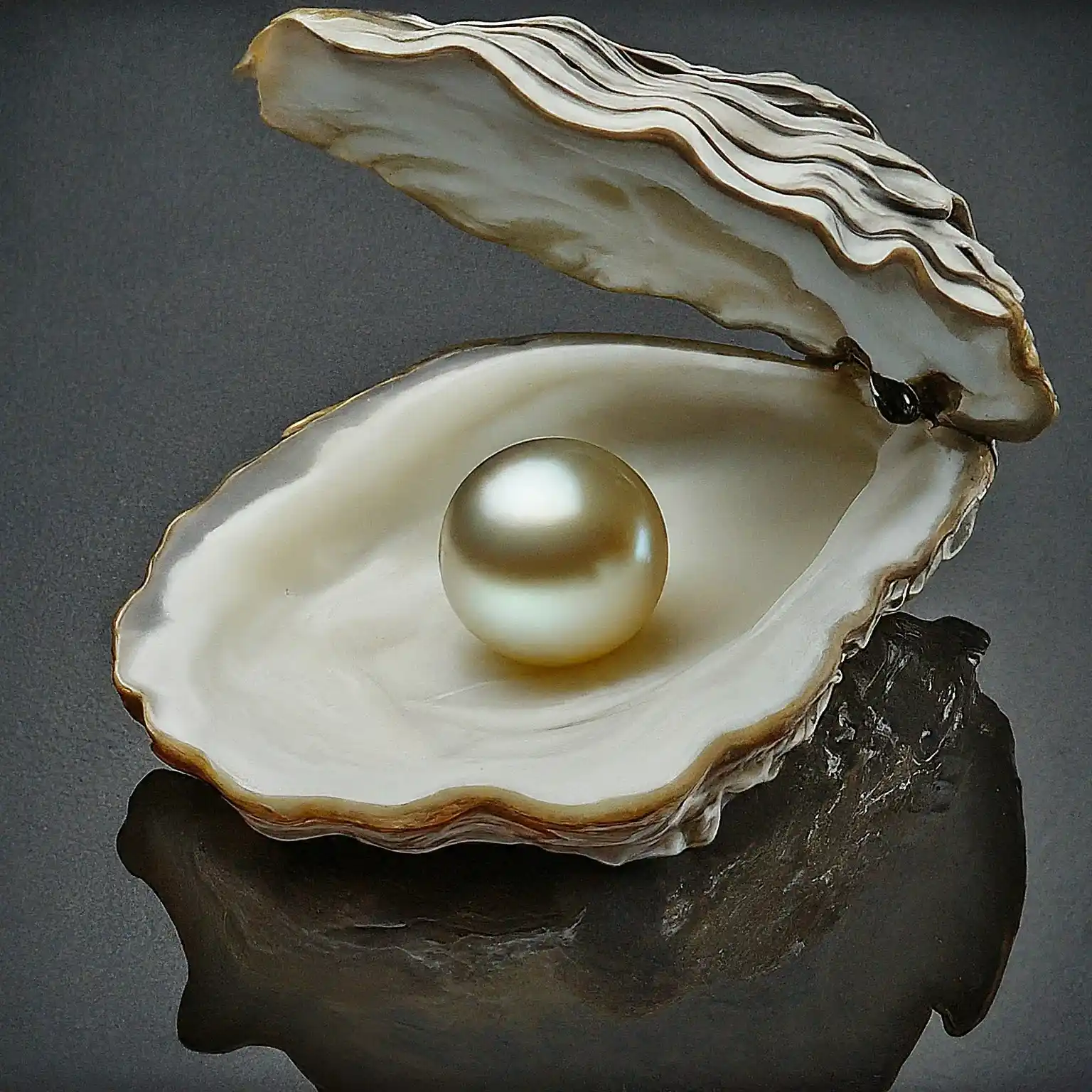
- Jewelry
Real vs. Fake Pearls: The Ultimate Guide to Telling the Difference
Table of Contents
Understanding Pearls
Before diving into identification methods, it’s crucial to understand the types of pearls and their formation processes. Pearls are classified into two primary categories: natural and cultured.
- Natural Pearls: These are formed without human intervention, occurring when a foreign object enters the mollusk’s shell. The mollusk secretes layers of nacre around the irritant, gradually forming a pearl. Natural pearls are rare and often very expensive.
- Cultured Pearls: These are created by inserting a bead or piece of tissue into the mollusk to stimulate nacre production. Cultured pearls come in various types, including Akoya, Tahitian, and South Sea, each with distinct characteristics.
1. Methods to Identify Real Pearls
1.The Tooth Test
One of the simplest and most effective tests is the tooth test. Rub the pearl against the edge of your teeth. Real pearls will have a gritty, sandy texture due to their natural nacre layers. Fake pearls, especially those made of plastic or glass, will feel smooth and slippery.
2. The Weight Test
Pearls are relatively dense. When comparing a real pearl to a fake one of similar size, the real pearl will generally be heavier. Use a precision scale to measure the weight if you have one available.
3.The Luster Test
Pearls exhibit a unique luster, known as iridescence, which is a result of the light reflecting off their nacre layers. Real pearls will have a deep, rich luster that changes with the angle of light. Fake pearls often have a more superficial shine and lack the depth and warmth of genuine pearls.
4.The Nacre Thickness Test
Nacre is the substance that gives pearls their shine. Real pearls have a thick layer of nacre, while fake pearls have a thin coating or none at all. To test nacre thickness, you can look for the nucleus (core) of the pearl. In real pearls, the nacre covers the nucleus, which is typically difficult to see. In fake pearls, especially those made of plastic, you can often see the core or a noticeable seam.
5.The Surface Inspection
Real pearls may have natural blemishes, including slight irregularities and imperfections. These imperfections are a hallmark of authenticity. Fake pearls are often perfectly smooth and uniform, lacking the natural variations of real pearls.
6.The Heat Test
Real pearls are relatively heat-sensitive. Exposing a pearl to heat for a short period will cause it to react by becoming dull or discolored. Fake pearls, especially those made of synthetic materials, will not be affected by heat in the same way.
7.The X-Ray Test
For a more scientific approach, you can use an X-ray to examine the internal structure of the pearl. Real pearls will show concentric layers of nacre, while fake pearls will reveal a solid core or a hollow center with a coating.
8.The Light Test
When held up to a bright light, real pearls will display a unique play of colors known as orient. This phenomenon is caused by the way light interacts with the multiple layers of nacre. Fake pearls may not exhibit this effect or may show a more artificial shine.
9.The Visual Test
Observing the pearl’s overall appearance can also provide clues about its authenticity. Real pearls often have a slightly irregular shape and varying sizes, while fake pearls are often perfectly round and uniform.
10.The Professional Appraisal
If you’re still unsure about the authenticity of a pearl, consider taking it to a professional jeweler or gemologist. They can use specialized tools and techniques to accurately determine whether a pearl is real or fake.
2. Common Types of Fake Pearls
1.Plastic Pearls
Description: Plastic pearls are among the most common and least expensive imitation pearls. They are made from plastic beads coated with a shiny, pearl-like finish. This coating gives them the appearance of real pearls but is superficial.
How to Identify:
- Weight: Plastic pearls are notably lighter than real pearls. If you have a pearl necklace or bracelet and it feels unusually light for its size, it may be made from plastic.
- Nacre: Real pearls have a layer of nacre, giving them their depth and luster. Plastic pearls lack this nacre layer, resulting in a more artificial, less complex shine.
- Surface: Examine the surface closely. Plastic pearls often have a more uniform and less nuanced finish compared to the subtle variations in genuine pearls.
- Scratching Test: Rub the pearl against the edge of your teeth. Plastic pearls will feel smooth and slick, whereas real pearls will feel slightly gritty due to the natural nacre.
2. Glass Pearls
Description: Glass pearls are made from glass beads coated with a pearlescent finish to mimic the appearance of real pearls. They are heavier than plastic pearls but still fall short in replicating the true luster and depth of genuine pearls.
How to Identify:
- Weight: While glass pearls are heavier than plastic ones, they are still lighter than real pearls. Compare the weight of a suspected glass pearl with that of a known real pearl of similar size.
- Luster: Real pearls have a deep, iridescent luster that changes with the angle of light. Glass pearls often have a more superficial shine that lacks the depth and warmth of genuine pearls.
- Reflective Quality: Light passing through glass pearls often reveals a more artificial, less complex play of light. Real pearls scatter light in a more intricate manner due to their multiple layers of nacre.
- Surface Finish: Examine the coating. Glass pearls may have a more uniform and potentially imperfect coating that can show signs of wear and tear more quickly than real nacre.
3. Imitation Pearls
Description: Imitation pearls are crafted from various materials, including beads coated with a pearlescent substance or painted to mimic the look of real pearls. These pearls can range from basic plastic or glass to more sophisticated coatings that closely resemble the appearance of genuine pearls.
How to Identify:
- Material: Imitation pearls can be made from multiple materials, often resulting in a less consistent quality compared to real pearls. Assess the material by observing its feel and weight.
- Luster and Depth: The luster of imitation pearls is often less sophisticated. Genuine pearls exhibit a deeper, more complex play of light due to the nacre layers. Imitation pearls may have a more superficial shine.
- Surface Characteristics: Look for imperfections and irregularities. Real pearls will have subtle surface imperfections and variations, while imitation pearls often appear too perfect and uniform.
- Authenticity Tests: Conduct common authenticity tests like the tooth test or the heat test. Imitation pearls will generally fail these tests, showing signs of artificial construction or coating.
Understanding the common types of fake pearls and their distinguishing features is crucial for anyone looking to invest in or purchase pearls. By examining the weight, luster, surface finish, and conducting simple tests, you can more accurately determine whether a pearl is real or imitation.
When in doubt, consulting with a professional jeweler or gemologist is always recommended. They can provide expert insights and utilize specialized tools to verify the authenticity of pearls. Investing in genuine pearls not only ensures that you are purchasing a high-quality product but also adds value to your collection or gift.
3. Conclusion
Identifying whether a pearl is real or fake requires a combination of methods and attention to detail. By using the tooth test, weight test, luster test, and other techniques, you can accurately determine the authenticity of a pearl. If in doubt, consulting a professional jeweler is always a wise choice.
Investing in real pearls not only ensures you are getting a genuine product but also supports the traditional craft of pearl cultivation. Whether you are buying pearls for yourself or as a gift, understanding how to identify real pearls will help you make informed decisions and appreciate the true value of these beautiful gemstones.
Related Posts
Fall in Love with Jewelry, Stories, and Secrets
Join Artemies Magazine for insider jewelry tips, trend updates, and subscriber-only discounts.




2 thoughts on “Real vs. Fake Pearls: The Ultimate Guide to Telling the Difference”
I used to be suggested this website by way of my cousin. I am now not positive whether
or not this submit iis written via him as no one
else realize such designated approximately my problem.
You are wonderful! Thank you!
we are glad to hear that the website helped you and it seems like your issue is resolved. we’re always happy to assist. If you have any more questions or need further help, feel free to reach out!”